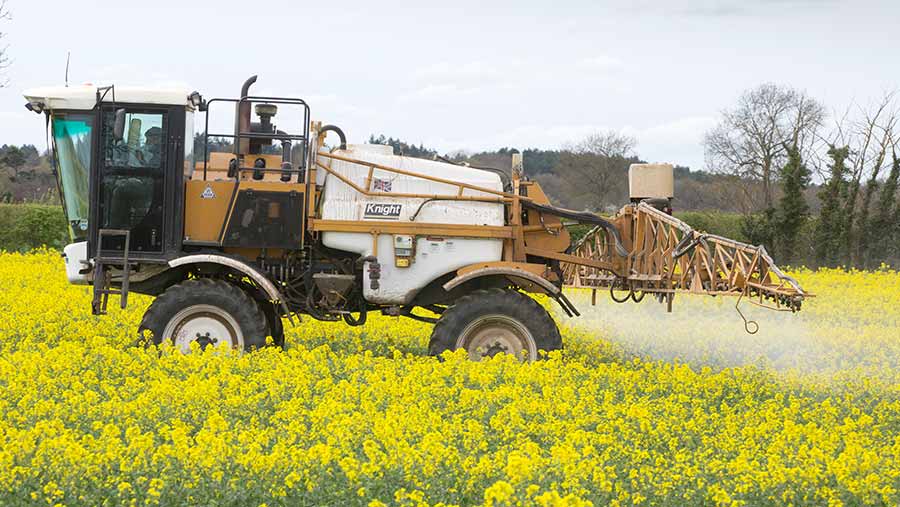Crop Watch: Slowly catching up with fieldwork backlog
It’s all systems go as the drier weather has enabled the first decent spell of fieldwork. Drilling, spraying and fertiliser applications all need to be done at the same time.
The late spring has forced agronomists to make tough decisions about prioritising tasks. Their thoughts now turn to making plans for T1 fungicides in wheat, as well as sclerotinia sprays in oilseed rape crops that are starting to flower.

© Tim Scrivener
North: Patrick Stephenson
AICC (Yorkshire)

Patrick Stephenson
I would like a pound for every litre of diesel that has been burnt in the past week. As we expected, the to-do list is long and the main priority remains fertiliser applications.
Winter barley crops are now flying and although the first growth regulator and fungicide has just been applied, I am already leaving recommendations for the second growth regulator.
As many of you are aware, the price of straw is now more than £130/t, so when the agronomist recommends another growth regulator, clients immediately refer to the straw price. I remind them that a flat crop produces even less.
See also: 3 top varieties to consider as second wheats this autumn
In terms of disease control, my thoughts start to turn to ramularia as we approach flag leaf. So chlorothalonil will be in the mix. Overall, crops look reasonable, but I fear the late spring will have cost some potential.
Variable OSR
Winter rape crops are a real mishmash and although some are starting to flower, others look as if flowering will be closer to Christmas than summer.
Variable growth can sometimes be attributable to flea beetle larvae in the stems. Although there is little we can do, it is worthwhile understanding that this pest is an issue for us.
Pollen beetles are also abundant and although there are thresholds, I am very reluctant to treat. I think the pyrethroids are largely ineffective and they are also not selective. We will see if I hold my nerve.
Sclerotinia sprays will be next on the list. Although I expect the flowering to be short, when I look at the in-crop growth variations, getting timings right across the field could be a real challenge.
Winter wheats have eventually received fertiliser and are starting to grow and look more promising. The late October and early November drillings look the worse and as you walk these fields, the top is like the skin of a rice pudding.
There has been much debate on the need for T0 applications. The reality is that in my part of the world, many crops will be ready for T1 as you read this, so you’re too late. Those who applied some growth regulator, manganese or herbicide earlier included some fungicide on the more disease-prone varieties.
Tank mixes can be a challenge at this time of year and anything above four products carries an increased risk of crop effect, so take care.
In less than six weeks wheat ears will be emerging and although yellow rust can be easily found, surely we can manage it with a standard programme?

Giles Simpson
West: Giles Simpson
Pearce Seeds (Somerset)
We have finally had a decent period of dry weather – probably the first since last August.
Spring cereals are thankfully now all drilled. Seed rates were stepped up slightly and seed-beds have generally been good, but patience was needed.
I do have to question some methods of drilling, such as using a 275hp, fully weighted 11t tractor on a 3m combination drill and then wondering why it won’t travel.
All winter crops have now received some nitrogen. The crops still have to take this up, but hopefully they will change colour quickly. The winter barleys have suffered the worst and had gone very yellow – yield will surely be affected.
The normal three-way split of nitrogen has become a two-way split, with the first application made very late, probably three to four weeks later than it should have been.
T1 spray
Disease levels are generally low and a T1 will be applied as soon as possible.
The winter wheat that received nitrogen earlier is looking good and where the T0s were applied, crops are relatively free of disease. The T1 spray is now imminent in the next week. A robust growth regulator is being used to try to encourage root development.
The T1 fungicides will be a combination of chlorothalonil, an SDHI and an azole. Where no T0s have been applied the rates will be kept up. Septoria is the main concern and in the South West you can’t let it get away.
There has been an abundance of weeds appearing in grassland. If only we could find a use for docks. I don’t know why we have seen an onslaught of weeds, but the long, wet winter and late spring must surely have something to do with it.
With the workload now being caught up, attention is turning to maize drilling, which has just started here in Dorset. Like last year, I will be applying a pre-emergence spray to the majority of maize fields – we certainly won’t be short of moisture.

Kevin Knight
South: Kevin Knight
Zantra (Kent)
I’m caught between land being too wet to drill and it baking into clods as soon as it is moved to get some air and warmth into it.
Spring drillings could do with rain to get them going. Conversely, I have winter wheat that still has ducks merrily paddling around in wet holes.
Some beans have gone in well, but are now facing serious weevil pressure and are bizarrely also crawling with flea beetle in places.
If you have spring oilseed rape or brassicas in the ground, monitor them closely, as the past 10 days have gone from no flea beetles to way above the threshold. Resistance is present, so use appropriate actives, along with water conditioners and wetters to get the best effect where needed.
Spring barley and oats still have to be drilled this week, albeit with reduced expectations, and their management will reflect this. I’ve pulled the plug on spring wheat and beans and am now looking to linseed to fill the gaps.
Flowering OSR
Oilseed rape has hurled itself into flowering. If ever a season illustrated how quickly pollen beetles move to opening flowers and leave buds alone, this is it. They are pollinators, so I recommend saving the insecticide spend for seed weevil and pod midge suppression.
The gap from T0 to T1 is looking to be 10 days on average. Many of mine had a “T0 lite” added to a herbicide, so T1 will be robust in terms of fungicide and plant growth regulator. There is a lot of yellow rust and septoria about, with brown rust in susceptible varieties.
An SDHI (penthiopyrad) + azoxystrobin + azole + chlorothalonil will form the bulk of my recommendations, along with chlormequat + Moddus (trinexapac-ethyl) or Canopy (mepiquat + prohexadione). These have already been applied to early-drilled wheat this week as leaf two is fully emerged. Later-drilled crops will be there next week.
Fertiliser timings have been all over the place. Provided you got a base dressing on in March, get 170Kg of N available between second node and flowering and you’re in the right ball park.

Marcus Mann
East: Marcus Mann
Frontier (Essex)
Soils have responded well to the improving conditions, but dig down below the surface and there is still evidence of the cold, wet start to 2018.
Crops that have been drilled have gone into warmer seed-beds with adequate moisture, which is resulting in quick emergence with plenty of vigour. This was critical for the late spring drilling.
Winter cereals are responding well to the improving weather and nitrogen, and are rapidly approaching the T1 timing. Many T0s have been missed or delayed because of the inability to travel and the reduced yellow rust pressure.
Septoria, however, can be found in most varieties, even those with higher resistance ratings. Visible symptoms can be seen on older leaves and it is highly likely that leaves three and four will contain high levels of latent disease.
With this in mind, fungicide strategies will be adjusted, with higher rates of SDHI mixed with robust rates of azole along with a protectant.
Earlier T1
In a lot of cases where no T0 has been applied, and considering spraying capacity and the backlog of other field work, the T1 may need to be pulled forward slightly from the ideal timing.
If this is the case, it is imperative that the gap between T1 and T2 isn’t stretched much beyond three weeks.
Depending on what happens with the weather in the next seven to 10 days, it may be wise to plan a leaf two spray now to try to keep both it and the flag leaf clean of septoria before T2s are applied.
Winter oilseed rape has begun flowering and early flower sclerotinia programmes are being discussed. Current reports show sclerotinia germination in the West. However, with milder weather and thunderstorms predicted, this risk will become more widespread.
Recent wet weather has increased chocolate spot pressure and lesions are being found in crops of winter beans. If the weather remains humid, it would be worth monitoring and, if necessary applying a pre-flowering fungicide.

